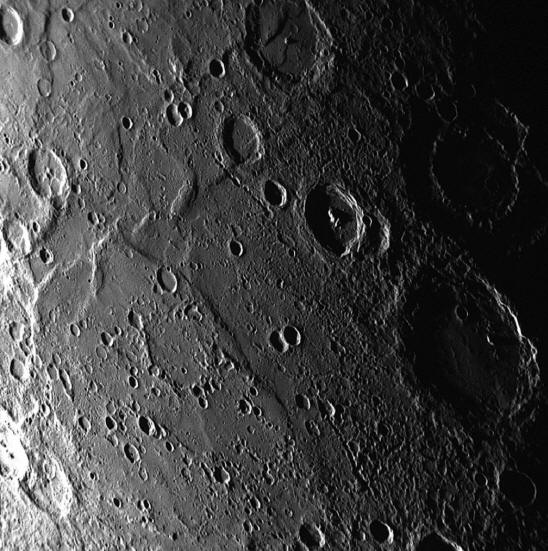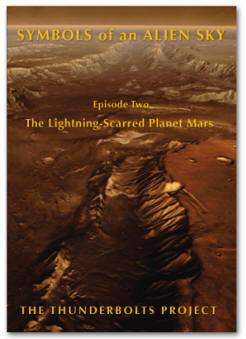|

Unusual cratering on Mercury's far
side. Credit: NASA/Johns Hopkins
University APL/
Carnegie Institution of Washington
MESSENGER in Orbit
Mar 23, 2011
After a seven year journey the
space probe is now Mercury's first
satellite.
On August 3, 2004, NASA launched
the Mercury Surface, Space
Environment, Geochemistry and
Ranging (MESSENGER) experiment from
Cape Canaveral. After
traveling nearly eight billion
kilometers, the 485 kilogram
spacecraft initiated orbital
insertion around Mercury on March
17, 2011. It will begin its
scientific mission on March 23,
2011.
Mercury is a small planet, 4878
kilometers in diameter. Jupiter's
moon Ganymede and Saturn's moon
Titan are both larger. Mercury
revolves at a mean distance of
57,910,000 kilometers from the Sun,
so a year on Mercury lasts 88 days.
Since it rotates once every 58.6
days, the planet completes three
rotations for every two orbits.
Mercury, like most bodies in the
Solar System, has a weak magnetic
field, but scientists have no idea
how it is generated. A magnetometer
on the MESSENGER satellite should
help resolve where the magnetic
field originates. Modern theories
suggest that it is a rotating
"dynamo" of molten metal inside
Mercury, although no one understands
how a molten core exists on Mercury
since the planet appears cold and
dead. The molten interior should
have cooled off eons ago.
Considering its estimated high
density, Mercury is believed to be
almost 75% iron surrounded by a thin
shell of silicon-rich rock.
Consensus theories about
protoplanetary nebulae cannot
explain the abundance of iron: the
ratio of iron to silicon is opposite
that of the other rocky planets.
Mercury's temperature exceeds 400
Celsius at noon, and it receives an
average of nine times more radiation
at its surface than the Earth. Since
it is bathed in searing heat, and is
bombarded by charged particles from
the Sun, how can it possess a
detectable atmosphere?
According to planetary
scientists, a planet with a gravity
field only 38% that of Earth, and
under such intense solar
irradiation, should not possess the
smallest remnant of an atmosphere.
It is possible that Mercury could be
a young planet, so, like Titan (a
possibly young moon of Saturn), it
retains some of its primordial
envelope despite low gravity.
During MESSENGER's second flyby
of Mercury, electromagnetic flux
tubes were found connecting the
planet's weak magnetic field
directly to the Sun with gigantic
filaments of electric current. In
April of 2009, NASA’s THEMIS
satellites found similar "electric
tornadoes" above Earth at the
interface between the magnetosphere
and the Sun's ionic wind.
Such currents are familiar to
plasma physicists and Electric
Universe proponents. It is those
helical "Birkeland currents" that
confine plasma and allow electricity
to flow over great distances. The
presence of electric forces flowing
like giant tornadoes into Mercury
hint at a time when those forces
might have been far more powerful.
As mentioned in a Previous
Picture of the Day, there could have
been a period in Mercury's history
when those helical currents were
energized to the glow mode or the
arc mode stage. If that happened,
then the surface of Mercury would
have been the scene of gigantic
electric discharges blasting out
craters, cutting vast chasms, and
rearranging the atomic structure of
the planet's crust over large areas.
One of the most intriguing
features on Mercury is the
Caloris Basin, a
1300-kilometer "astrobleme" that
supposedly caused shockwaves to pass
entirely through the planet. On the
opposite side of Mercury are bizarre
folds and uplifts that are said to
be from the antipodal compression of
the crust as the tremendous pressure
partially melted and then
re-solidified the strata. The
Caloris Basin resembles other
multi-ringed "impact"
structures we have previously
discussed in other Picture of the
Day articles.
Multiple basins
found on Mercury, just as on
several other celestial bodies,
are probably formed when electricity
erodes material from the surface.
Craters are usually circular because
the electromagnetic forces constrain
them to strike at right angles to
the surface. If an electric arc is
composed of two filaments rotating
around a common center, the surface
will be excavated by a plasma "drill
bit," leaving steep sides and a
“pinched up” rim of debris. If
several filaments are involved, the
plasma beams can cut one crater
within another, sometimes with one
or more smaller craters on the rims.
Most of the debris on the surface
of Mercury appears to be chunks of
fallback material that was blown out
by the explosive energies of plasma
discharges. Ordinarily, as in the
image at the top of the page, the
craters have little if any ejecta
surrounding them.
Indeed, a close examination of
some of those concentrations of
craters reveals them to be woven
together in patterns that crisscross
and braid themselves over and under
one another. They all lie along the
path of
flat-topped mesas that
rise above deep chasms cutting
across the landscape without regard
to the elevation. Many times the
chasms slice right through the
middle of a crater and its central
mountain peak as if they weren’t
there.
How does the Electric Universe
hypothesis account for the volumes
of information returned by missions
such as MESSENGER? The Electric
Universe provides simple yet
surprising answers to that question
in such publications as, "Astronomical
Myths of Mercury and the Sun,"
by Wal Thornhill. With MESSENGER's
mission in orbit around Mercury it
is likely that additional
observations will confirm our
hypothesis.
Stephen Smith
 New
DVD New
DVD
The Lightning-Scarred
Planet Mars
A video documentary that could
change everything you thought you
knew about ancient times and
symbols. In this second episode of
Symbols of an Alien Sky, David
Talbott takes the viewer on an
odyssey across the surface of Mars.
Exploring feature after feature of
the planet, he finds that only
electric arcs could produce the
observed patterns. The high
resolution images reveal massive
channels and gouges, great mounds,
and crater chains, none finding an
explanation in traditional geology,
but all matching the scars from
electric discharge experiments in
the laboratory. (Approximately 85
minutes)
Video Selections
Order Link
|





 New
DVD
New
DVD

